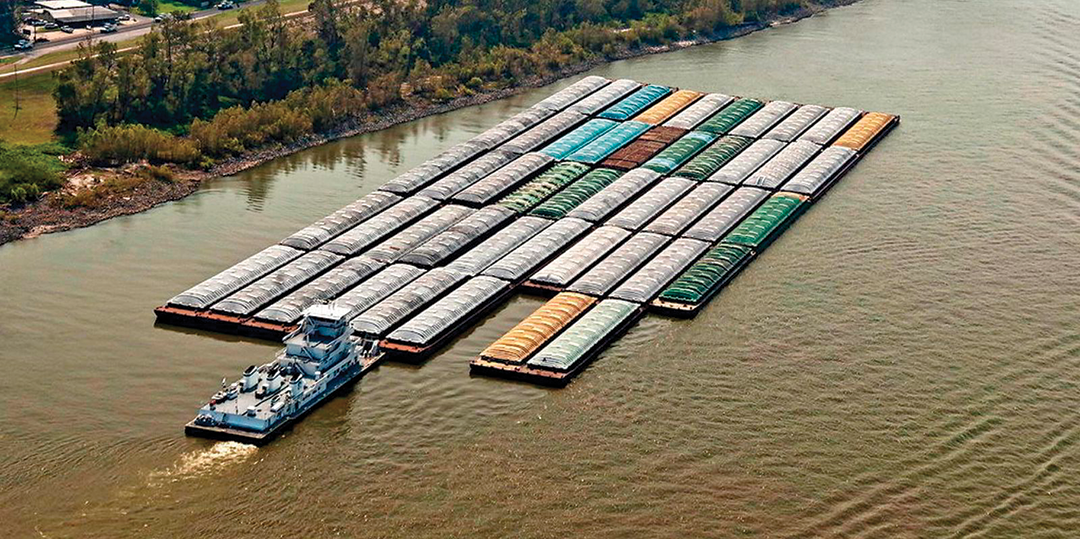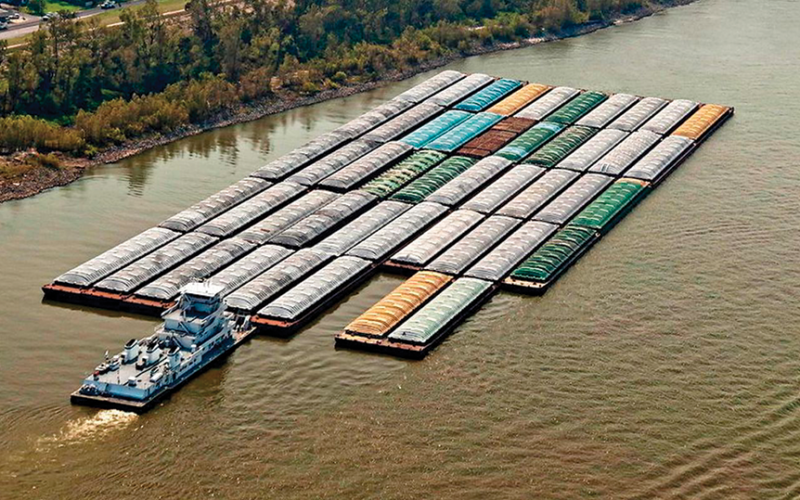
and petrochemicals move through the Port of South Louisiana.
A vision for the future of the maritime sector on the lower Mississippi is coming to fruition step-by-step as plans advance to eventually build a fleet of hydrogen bunker barges that is expected to carry the region into a new era of clean fueling.
With the technical expertise of the Seattle-based Elliott Bay Design Group (EBDG), the Hydrogen Fueling Barge (H2P3) is an infrastructure investment project headed by the H2Public Private Partnership and the Port of South Louisiana (Port SL) that will develop a mobile clean-fueling station designed to serve the growing fleet of methanol-fueled river and harbor vessels operating in the lower Mississippi River corridor.
When completed, the H2P3 bunkering barge will be the first such purpose-built barge in the nation.
Optimized to serve as a clean fueling station to handle methanol and its conversion to hydrogen to power the newest generation of river vessels, the barge will feature operational and safety features specifically tailored to fuel tugs, workboats, and other harbor craft with lower freeboards and more frequent fueling demands.
EBDG is providing architectural and engineering services to PortSL for the design of the methanol-fueling barge.
According to EBDG principal, Mike Complita, while the project “is not directly affiliated with the Hydrogen One tug that Maritime Partners has commissioned, it is based off of that as a reference point.”
Maritime Partners of Metairie, La., is currently developing M/V Hydrogen One, the world’s first methanol-fueled inland tug. “It’s the world’s first vessel that will run off of methanol ‘reforming’ technology,” said Complita.
EBDG designed the towboat to run on “emissions-reducing methanol-to-hydrogen generator technology” without optional diesel propulsion.
With that technology, he added, “you load methanol onto a boat, you run it through the system and it produces hydrogen on board.
The ‘green’ hydrogen is then consumed in fuel cells to generate the electric power that’s needed to run the boat.”
But, Complita continued, it is critical to understand “that vessels are not actually being fueled with hydrogen. They are fueled with methanol that is converted into hydrogen on-board. That’s really important.”
Green hydrogen is different from traditional, “gray” hydrogen in that it is extracted from water, as opposed to natural gas.
The process calls for the hydrogen to be extracted from water by an “electrolyzer,” which is powered by offshore wind-generated electricity. The result is an H2 molecule that is chemically identical to one made from gray hydrogen, but with zero carbon footprint.
The hydrogen is then available for numerous industrial uses including fuel for marine propulsion systems.
The PortSL barge is financed through government grant funding recently made available for the H2P3 project with several green technology organizations stating an interest in applying for a grant to produce or build similar methanol-hydrogen fueling barges.
The grant for the one-year H2P3 project is as much as $590,000 over one year, according to several sources,
“I would certainly be willing to say that the price of [building and maintaining] a methanol barge should be similar to a conventional bunkering barge,” said Complita.
While “not at liberty” to share the barge’s exact specifications, Complita said the barge’s hull “will be based on conventional 297-foot inland river system barge dimensions and construction to optimize construction efficiency and cost while also ensuring a platform that is already familiar and easily accessible to tug and barge operators.”
The design, he added, “will include fueling points at both ends of the barge, so that more than one vessel can tie up and fuel at the same time.”
In effect, the hydrogen-fueling barge would position Port SL as the Lower Mississippi’s “go-to methanol fueling depot” and provide limited metered quantities of methanol similar to a “floating gas station.”
Ultimately, said Complita, “every major port will need a barge like this to fuel methanol vessels.”
Hopefully, he added, “the design will be done by the end of the first quarter of this year, or early into the second quarter and then the port will go out to bid for construction.”
Work on the project is reportedly slated to begin by the end of this year and take another year to complete.
PortSL “will likely treat this as a conventional bunkering barge as far as the majority of the rules and regulations go,” he said. “So, there’s really nothing particularly novel or concerning from a regulatory perspective for this in the long run.”
H2P3 “will become an example for more of these types of barges as time goes on and as the use of methanol fuel vessels expands.”
The Port of South Louisiana “has a long history of fueling the nation and the world,” said Paul Matthews, CEO of Port of South Louisiana.
“Our port has committed to leading America’s energy transition along the Lower Mississippi River and we are thrilled that this first of its kind hydrogen fueling barge will bring a fleet of low carbon vessels into commerce,” he said.
“This is a small, yet meaningful step in a larger movement to reduce our carbon footprint.”

